The international exchange exhibition Datumsoria featuring Nam June Paik, Liu Xiaodong from China and Carsten Nicolai from Germany shows how the data environment in the post-digital age is integrated into our life as well as transforms and extends human senses. ‘Datumsoria,’ a neologism from the combination of the words datum and sensoria (the seat of sensation), means the creation of a new perceptual space between the real and the virtual in the information era of the 21st century. The three participating artists all explore the themes of the real, new media and the effect of the environment on human sensation and perform various artistic experiments. Nam June Paik shares his fascinating predictions and insights on the changes that technological media would bring to the real world and humans. Liu Xiadong, who photographs real landscapes and brings them into the exhibition space, reconstructs them in a mechanical way, while overlapping the real and virtual world continuously. Carsten Nicolai recreates punch cards used in early digital computers on a huge and endless screen, thereby delivering auditory and tactile senses of the real to viewers.

- Venue
- Nam June Paik Art Center, Gallery 2
- Date
- Jul 12— Sep 16, 2018
- Artist
- Nam June Paik, Liu Xiaodong, Carsten Nicolai
- Hosted and Organized by
- Sponsored by
- Goethe-Institut
- Curator
ZHANG Ga(Director, Chronus Art Center), Lee Sooyoung(Curator, Nam June Paik Art Center)
- In Cooperation with
CAC | Chronus Art Center (China), ZKM | Center for Art and Media Karlsruhe (Germany)
- Supported by
Sandol Cloud, Buzzshop, Perrier
-
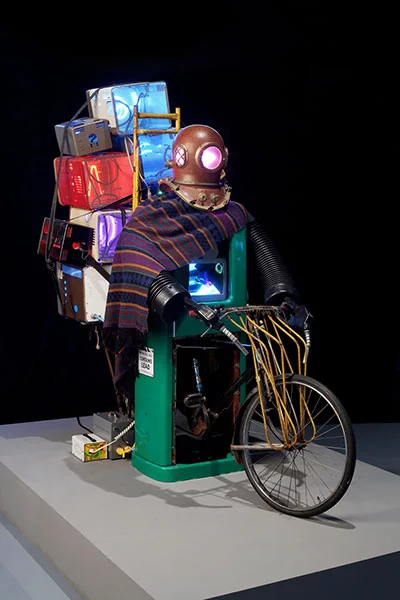
Nam June Paik, The Rehabilitation of Genghis-Khan (1)

1993, Media Sculpture, TV monitors, neon tube, bicycle tire, 217x110x211xcm
The Rehabilitation of Genghis-Khan is a robot sculpture produced on the occasion of the Venice Biennale 1993, materializing the concept of the garden of German Pavilion becoming a new Silk Road that connects the East and the West and the fact that the historical highway has been substituted with a broadband electronic highway. This Genghis-Khan of the 20th century is riding a bike instead of a horse, wearing a diving helmet. His body is made of a fuel dispenser made of steel and his arms plastic pipes. The back of his bike is loaded with television cases, which are filled by symbols and characters made by neon lights. The neon symbols suggest a possibility of condensed delivery of complicated information through an electronic highway. The video displayed on the screens present a series of images that morph themselves, i.e. from a bottle to a pyramid and from a ceramic bowl to a kettle, while abstract geometrical patterns are alternating. In his robot sculptures such as Marco Polo, Alexander the Great and Tangun as a Scythian King, Nam June Paik emphasizes the coming of an age with a new paradigm that is realized with the help of software development through broadband communication, which is a step forward from the old age when power and domination were achieved by means of transportation and movement.
-
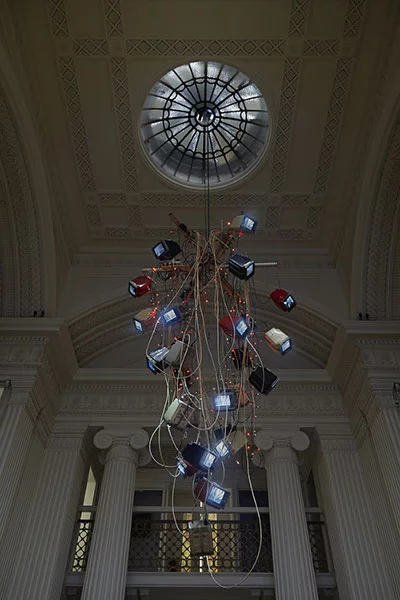
Nam June Paik, Video Chandelier No.1,

1989, Video Installation, 38 b&w monitors, 1-channel video, color, silent, 95:00, 23x18x13cm(monitor)/180x400cm
This is the first one of the series which is made up of a number of small monitors and suspended from the ceiling in the form of chandelier. Unlike later ones, the monitors in this version are all black and white, which is rare in the chandelier series. The cables and monitors are tangled up, but the entire piece comes to take the form of a beautiful splendid chandelier. The whole space of the chandelier with the kinetic composition from top to bottom, moving images on the screens, and light bulbs switched on in places is overwhelming and provides audiences standing below the chandelier with the new experience of spectatorship.
-
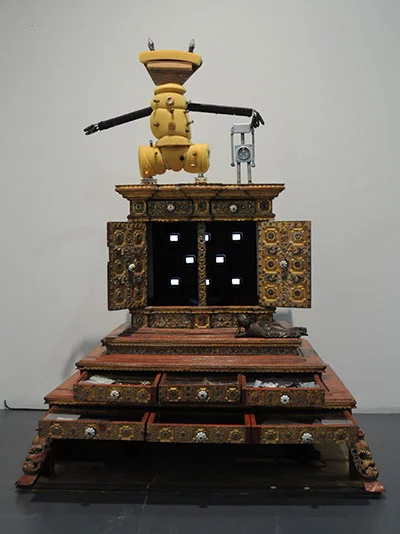
Nam June Paik, Burma Chest

1990, Media Sculpture, drawer, TV monitors, projectors, 1-channel video, color, silent/2-channel video, color, silent, 240x183x140cm
This is a Myanmar-style chest with a drawer in the upper part and another two-drawer unit in the lower part. The former contains eight small monitors displaying images and two projectors on both sides that respectively show a female nude and Charlotte Moorman’s performance, while the latter contains various ornaments, drawings, photographs, and so on. These drawers of the chest not only have their own secret, but also are the reservoir of stories to release them to other people.
-
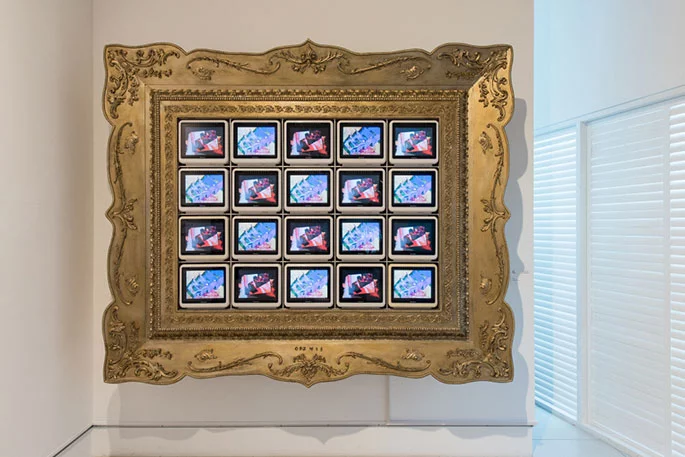
Nam June Paik, Fontainebleau

1988, Media Installation, 20 Quasar color monitors, metal grid, gold-painted wooden frame, 2-channel video, color, silent, 190 x 230cm
In a magnificent antique wooden frame painted in gold, 20 color (2-channel) monitors show rapidly-changing colorful abstract images. The title Fontainebleau was probably taken from the Fontainebleau castle in France; the castle was not only the splendid residence of French kings including Napoleon but also a prototype of the ‘gallery’, a space where paintings are hung side by side. The gallery of Francis I, in particular, displayed paintings on the walls surrounded by splendid gold decorations. “As the collage technique replaced oil painting, cathode ray tubes will replace canvas.” This is probably what Paik wanted to say through this work.
-
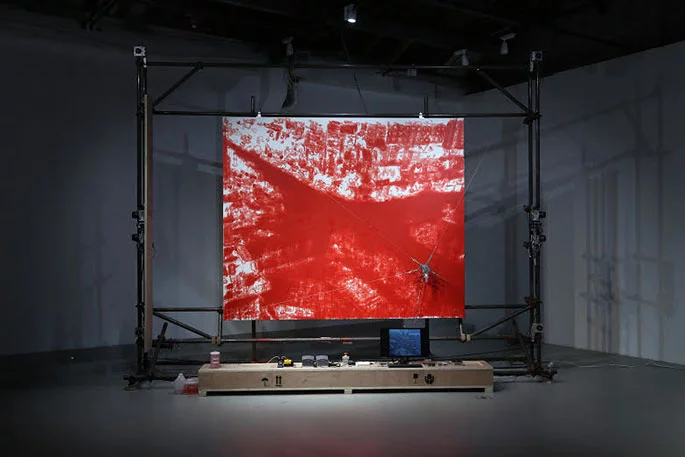
Nam June Paik, Burma Chest

2018, Multimedia installation, 2 robots, 2 canvases, live video streaming, dimension variable, Courtesy the artist and Lisson Gallery
Two large canvases are installed on a scaffolding. When landscape captured by video cameras is converted into data, a robot-controlled brush draws outline of buildings, silhouette of trees, contour of cars, shadow offigures meanderingly. The landscape that the machine keeps drawing on and on is a portrait of a city that cannot sleep. To install this work at the Nam June Paik Art Center, Liu put up cameras to shoot the views of Yongin and around the Jeonnam provincial office in real time, streaming the data to the center. Just as cities continue to change without sleep, the machine draws the world viewed by the cameras without rest. Liu’s work implies a new reality and our perception system changed by altered technological environment.
-

Carsten Nicolai, unitape

2015, Real-time projection, mirror walls, bench with loudspeakers
Carsten Nicolai is an artist and musician, who works intensively in the transitional area between music, art and science. In his work, he seeks to overcome the separation of the sensory perceptions of man by making scientific phenomena like sound and light frequencies perceivable for both eyes and ears. Influenced by scientific reference systems, Nicolai often engages mathematic patterns such as grids and codes, as well as error, random and self-organizing structures. unitape is based on an examination of perception and visual structures that allude to punch cards of the early computing era. The immaculate images and sounds are pure mathematical precision that illuminate an algorithmic sublime. The materiality of the generative data is manifested by the very projection medium and heightened in the mirrors, extending the field of imagery in infinite depth and breadth while the sonic cadence echoes reverberatingly to create a totality of sensory immersion.
Datumsoria











